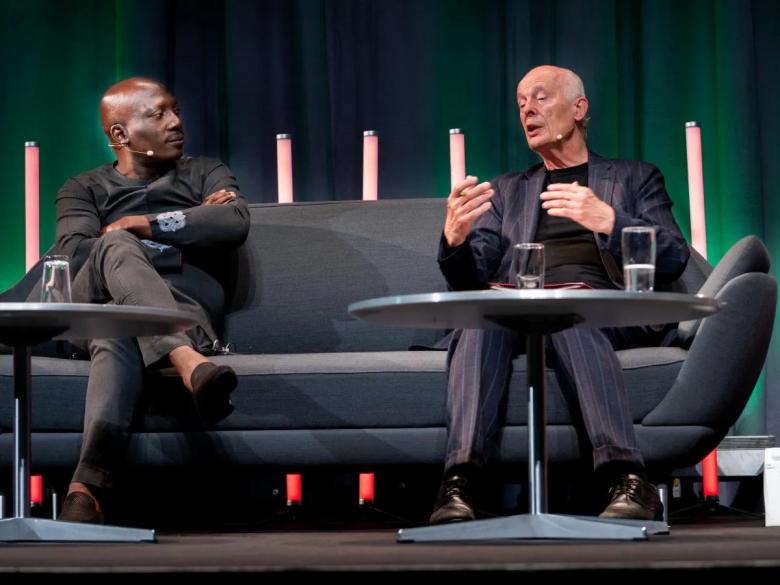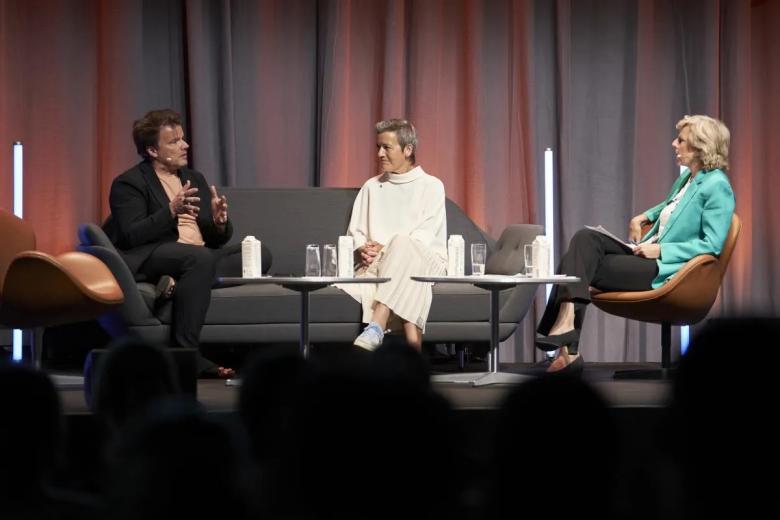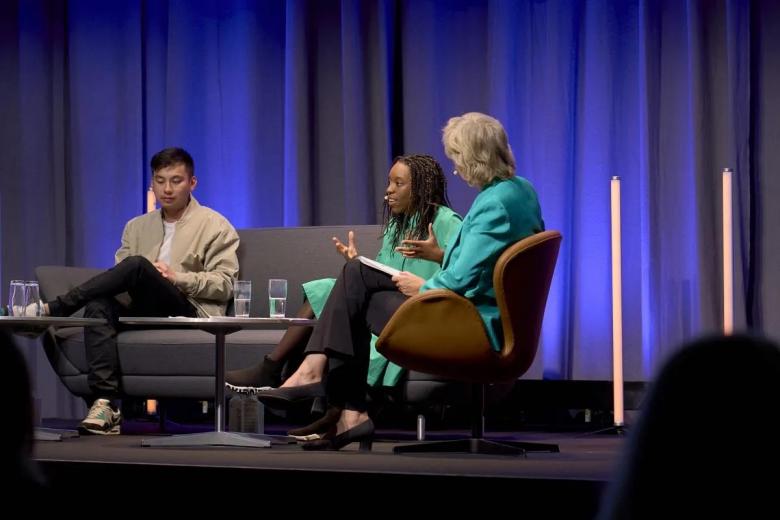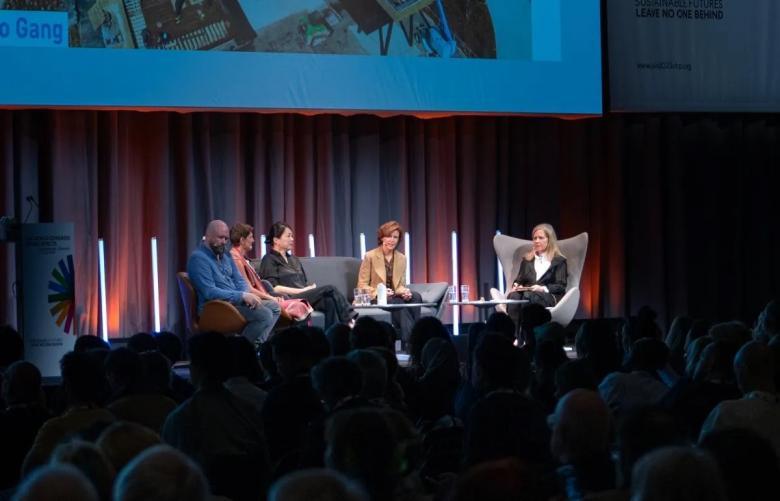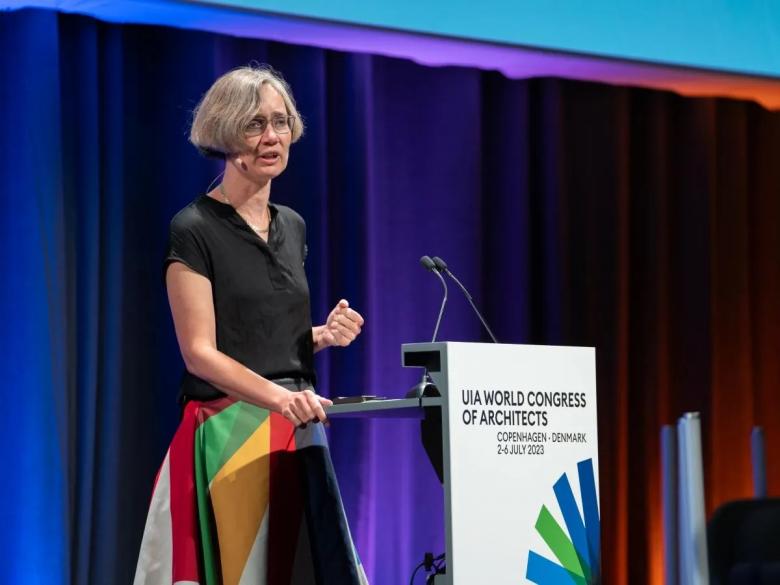17. July 2023
Kunle Adeyemi (NLÉ) and Hans Joachim Schellnhuber (founder of Bauhaus Earth) (Photo: UIA World Congress of Architects 2023)
During the first week in July, the World Congress of the International Union of Architects (UIA) took place in Denmark's capital. The focus of the discussions was the future-oriented and climate-friendly realignment of the construction industry in times of global warming.
In one of the talks at the UIA World Congress of Architects in Copenhagen, Hans Joachim Schellnhuber presented something that was deeply unsettling. While we are familiar with graphs depicting the one-directional trend of global warming, as well as statements about record-breaking hottest days or lowest water levels, what Schellnhuber showed was disturbing in a different way. With the current global measures in place, it is no longer possible to stay below the 2°C limit. It is challenging to even meet that target. His prognosis (Schellnhuber & Köllner, 2022) suggests a significant warming trend, with the Earth's climate slowly cooling down after more than seven decades of nearly 2.5°C of warming by the year 2100. When asked by moderator Connie Hedegaard about his confidence in "our chances" of success, he responded with crossed arms: 20%. His body language suggested a lack of optimism.
Bjarke Ingels (BIG) with Margrethe Vestager (EU Commission) and moderator Connie Hedegaard (Photo: UIA World Congress of Architects 2023)
135 nations in conversationIt is a challenge to adequately capture a congress like that of the UIA in words. Over three days, more than 400 international experts from around the world and from various fields such as architecture, design, politics, economics, and research delivered lectures, spoke on panels, and engaged in discussions. With participants from more than 135 countries, the Congress provided a unique platform for knowledge exchange. Most panels were designed to be followed by moderated discussions. Additionally, in the halls of the Bella Center in Copenhagen, it was possible to get to know specific projects in more detail and to discuss focal points and main themes with representatives of architects' associations from many countries. In some of these country pavilions, separate events could be attended. To complement the program, the Danish Architecture Center (DAC), for example, offered city tours with a focus on urban planning policies and current developments in the Danish metropolis.
H.Y. William Chan (Lord Mayor of Sydney) and Nyasha Harper-Michon (UNStudio) with moderator Connie Hedegaard (Photo: UIA World Congress of Architects 2023)
Urban development toward the north and southExamining urban developments in the context of the Congress is instructive: Copenhagen is growing rapidly, with around 1,000 people consistently moving to the city each month. Today, more than 650,000 people live in the densely populated metropolis, spread over just 82 km2. That equates to an incredible 7,878 inhabitants per square kilometer. For comparison, Berlin has 4,172, Hamburg has 2,455, and Munich has 4,868 inhabitants per square kilometer. Accordingly, the built density is omnipresent, and particularly evident in Copenhagen's more recent urban planning projects. For the past 30 years, the Ørestad district has been under development on the island of Amager, south of the city center, on 310 hectares of land. The Finnish office ARKKI is responsible for the master plan of this urban expansion (competition in 1994). However, the relatively monotonous arrangement of numerous multi-story residential and commercial buildings quickly creates the impression of a bedroom community. The metro, which was only put into operation in Copenhagen in 2002, operates fully automatically and provides very regular service to this somewhat faceless environment.
A new and better approach is being pursued in the northern part of the city, where the former free trade port, with its old warehouses and silos, has been transformed into a place for living and working. The architectural firm Cobe won the urban design competition for the master plan in 2008, which not only set the framework for the development and district plan but also included the design of public spaces, bicycle infrastructure, and subway stations. Over the next few years, this and two other planning areas in the northern part of the city aim to create housing for a total of 100,000 people, with a special focus on sustainability and inclusivity despite the high price level. Alongside luxury residential buildings, the development also includes a student residence, a recycling station, and a playground and sports field on the rooftop of the centrally located parking garage (the Cobe project page gives a good overview of the area).
So it’s fortunate that the UIA Congress likewise addressed the very question of a sustainable future and how everyone can be part of this process. "Leave no one behind" is the continuation of the title, confronting everyone equally with the great dilemma: It seems that the majority of our profession is aware that only sustainable, resource-efficient, and inclusive construction has prospects of a better future if we want to achieve a good life in a healthy environment for all. But what is the reality? While some speakers in their presentations demonstrated how they respond to global warming and rising sea levels through their architecture and projects, others used the platform to raise awareness of cross-cutting projects and call for participation.
Reinier De Graaf (OMA), Anna Heringer (Studio Anna Heringer), Xu Tiantian (DnA_Design and Architecture), Jeanne Gang (Studio Gang), and Martha Thorne (senior advisor, The OBEL Award) (Photo: UIA World Congress of Architects 2023)
The 10 Commandments: "Copenhagen Lessons"At the conclusion of the event, the UIA press office reported more than 6,000 participants. But what remains after Sustainable Futures – Leave No One Behind, after four days of the Congress? The Copenhagen Lessons were summarized and adopted – ten principles for a swift and fundamental transformation in the built environment, which could help achieve the United Nations' 17 Sustainable Development Goals (SDGs).
The numerous practical examples presented have shown that many architectural solutions contributing to sustainable communities already exist. Promoting and raising awareness about these solutions is certainly an important aspect. At the same time, all those involved in construction and financing must truly become aware of the immense influence the construction industry has in terms of CO2 emissions and the resulting amounts of waste.
The ten principles call for making inclusion and circular construction a requirement, prioritizing renovation over new construction whenever possible (and certainly no new buildings on existing green and open spaces), refraining from using materials for which there is no strategy for reuse, utilizing local materials, and producing no waste. The last two lessons state that in all built environments, carbon capture must exceed the carbon footprint, and every activity associated with construction must have a positive impact on water ecosystems and the provision of clean water.
Natalie Mossin, President of the UIA World Congress of Architects 2023, stated: "The Sustainable Development Goals define a crucial global agenda, which the built environment must contribute to. How we act on this must be bold – even radical, compared with current practice. With The Copenhagen Lessons, we present 10 principles for what that means when we construct, plan and develop the built environment. The health of the planet and basic human needs are on the line, we have no time to waste."
Natalie Mossin, President of the UIA World Congress of Architects 2023 (Photo: UIA World Congress of Architects 2023)
Optimistic about the future?Today, it is no longer about painting a doomsday scenario that is highly unlikely to occur. We can no longer ignore the rising sea levels, nor the accompanying migrations that should at best be planned in a sensible, comprehensive, and timely manner. Since April 2023, according to Climate Reanalyzer, the average surface temperature of the oceans has reached a new record high, surpassing the 21°C threshold. Oceans absorb excess heat from the air and store it for a long time. Trying to cool down the oceans in a warming atmosphere is like trying to cool down hot water on a hot summer day.
Business as usual can no longer be an option for the future, as it would lead to a temperature increase of at least 3°C by 2100. What does that mean? With a 1-to-3°C temperature rise, the ice sheets at the North and South Poles are already severely threatened, as are the alpine glaciers and coral reefs. The complete melting of the Arctic and Antarctic ice, as published by National Geographic in 2013, would result in the disappearance of most of our major coastal cities in Europe, including Amsterdam, London, Lisbon, Odessa, and Copenhagen. Similarly, cities like Mumbai, Calcutta, Bangkok, Shanghai, and Beijing would also be affected. Cities of millions whose inhabitants are forced to migrate in search of a safe haven.
It is therefore important to limit what is possible. After achieving a carbon-neutral footprint, the next step is to aim for carbon-positive buildings (and as many other things as possible), utilizing them as carbon sinks. This is not about energy-intensive carbon-capture methods, but rather about taking a new, more precise look at the process of construction itself. The extent to which the attending professionals will be able to incorporate what they have learned into their practice is questionable. Even though numerous business representatives and political activists were present, there was sometimes a feeling that the information was not being presented to the right audience. It is the clients, cities, municipalities, and federal states that need the competence to discuss issues of climate neutrality and CO2 positivity in day-to-day life. They must advocate for — or better: actively demand! — that construction includes everyone and everything, without compromising on material choices, resource conservation, and ecosystems.
In this respect, Hans Joachim Schellnhuber's words at the beginning of his talk work well here as a conclusion: "Do you actually know what's going on right now?"
Related articles
-
Lessons Learned?
on 7/17/23
-
UIA World Congress 2023
on 4/10/23
